The ability to start a fire is foundational for survival. For quite a while now, my primary fire-starting method has been a ferrocerium rod igniting cotton balls dabbed with petroleum jelly. My secondary method has been waterproof matches. I have been searching for a durable and reliable tool/process to be my tertiary fire-starting method. I wrote a little about this search in an article published on SurvivalBlog on January 10, 2021. This article is an update about the next stage in that search process.
 For Christmas this year, my wife gave me a permanent metal match. These are also known as forever matches, reusable matches, or immortal lighters. They are available in a variety of shapes and sizes from a host of vendors. By the way, if SurvivalBlog readers are aware of any permanent metal match that is manufactured in the United States, I would be interested in knowing about it. As with many other products, the vast majority of metal matches are manufactured in China.
For Christmas this year, my wife gave me a permanent metal match. These are also known as forever matches, reusable matches, or immortal lighters. They are available in a variety of shapes and sizes from a host of vendors. By the way, if SurvivalBlog readers are aware of any permanent metal match that is manufactured in the United States, I would be interested in knowing about it. As with many other products, the vast majority of metal matches are manufactured in China.
 A permanent metal match consists of two major parts: a metal rod and a fuel reservoir. The metal rod has a striker surrounded by wick material on one end and a threaded cap with a rubber o-ring on the other end. The fuel reservoir has a threaded opening that corresponds to the threads on the cap of the rod. The reservoir also has a ferrocerium rod embedded along its side. When the metal rod is unscrewed and removed from the reservoir, the striker can be run down the ferrocerium rod, creating sparks which in turn ignite the fuel infusing the wick material. Since the cap screws on tightly, it prevents fuel evaporation when the unit is not in use.
A permanent metal match consists of two major parts: a metal rod and a fuel reservoir. The metal rod has a striker surrounded by wick material on one end and a threaded cap with a rubber o-ring on the other end. The fuel reservoir has a threaded opening that corresponds to the threads on the cap of the rod. The reservoir also has a ferrocerium rod embedded along its side. When the metal rod is unscrewed and removed from the reservoir, the striker can be run down the ferrocerium rod, creating sparks which in turn ignite the fuel infusing the wick material. Since the cap screws on tightly, it prevents fuel evaporation when the unit is not in use.
First Impressions
The metal match I received is smaller and heavier than I anticipated, and appears to be quite durable. I found the somewhat whimsical filigree pattern decorating the exterior to be attractive. The reservoir on my unit measures just over two inches long and just over one half inch wide. The cap on the rod adds another half inch to the length of the unit.
The unit arrived without fuel. After filling, I quickly learned something that should be obvious: it is important not to tip the unit while trying to strike a spark with the metal rod. When the cap on the metal rod is removed from the threaded opening in the reservoir, fuel will leak out quickly if the unit is tipped.
The first couple of attempts to strike a spark were hindered by a protective coating on the ferrocerium rod. Subsequent attempts produced a nice shower of sparks. In my initial testing, it sometimes took several attempts to ignite the fuel in the wick material. I eventually learned that it can be helpful to shake the unit vigorously prior to removing the metal rod to assure that the wick material is thoroughly infused with fuel, especially if the reservoir is less than half full.
The Barn Test
I initially stored the unit out in my unheated barn in order to test it under the prevailing outdoor temperature conditions.
The unit can use a variety of different fuels. I used Zippo lighter fluid first. Naphtha based fuels like Zippo lighter fluid typically ignite more readily under cold weather conditions than kerosene. In traditional lighters, the primary drawback of naphtha based fuels is their high rate of evaporation. Since the metal match has a tightly sealed cap with an o-ring, I expected evaporation to be less of an issue than with traditional lighters. I had no problems consistently igniting the metal match under below freezing conditions while using Zippo lighter fluid.
Gasoline works well as fuel in an IMCO lighter. I was uncertain if it could be used as fuel in a permanent metal match. Logically, this should work okay, since gasoline is less volatile than naphtha based fuels. But since fuel spillage is more likely to occur from a metal match than from an IMCO lighter, I decided not to take the risk of using the match with gasoline as fuel. As testing proceeded, my decision to avoid gasoline as fuel was reinforced. On more than one occasion, the wick material brushed my gloves while I was handling the unit, leaving traces of fuel on my gloves. The sparks from the ferrocerium rod then at times briefly ignited the fuel on my gloves. These naptha-based fuel fires were easily extinguished by simply blowing on them. Gasoline fires may have been more difficult to extinguish.
While the match was in the barn, I used it for tasks such as relighting my outside wood boiler, sealing the cut ends of paracord, lighting an alcohol stove, test lighting various kinds of tinder, and similar tasks.
After three weeks of lighting the match an average of more than once a day, the fuel was finally expended. Even when the fuel was expended, the ferrocerium rod and striker could be used to create enough sparks to ignite a cotton ball.
The Immersion Test
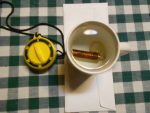 After completing the barn test and refilling the unit with fuel, I took it into the house and submerged it in a mug of water for an hour. At the end of the hour, I removed the unit from the mug, shook off the excess water, and attempted to light it. As long as the ferrocerium rod remained damp, it did not create sufficient sparks to ignite the wick material. But as the rod gradually dried, it began to create effective sparks, and easily ignited the wick material. The o-ring on the cap sealed the unit sufficiently to keep water from contaminating the fuel.
After completing the barn test and refilling the unit with fuel, I took it into the house and submerged it in a mug of water for an hour. At the end of the hour, I removed the unit from the mug, shook off the excess water, and attempted to light it. As long as the ferrocerium rod remained damp, it did not create sufficient sparks to ignite the wick material. But as the rod gradually dried, it began to create effective sparks, and easily ignited the wick material. The o-ring on the cap sealed the unit sufficiently to keep water from contaminating the fuel.
Dryer Lint
Lint from a clothes dryer is a useful and easily obtained tinder material. If you don’t happen to own a clothes dryer of your own, it would be a simple matter to collect dryer lint from the trash cans of your local Laundromat.
The dryer lint produced by our clothes dryer does not ignite as well as most other dryer lint while using a ferrocerium rod. Our lint contains too high of a percentage of dog hair. But even the dog hair does not prevent our lint from rapidly igniting when exposed to the flame of the permanent metal match.
Accelerant in Tubes
I mentioned above that my primary fire starting method uses a ferrocerium rod to ignite a cotton ball that has been dabbed with petroleum jelly. The cotton ball ignites quite easily, and then in turn ignites the petroleum jelly. The jelly then burns for a minute or two using the cotton as a wick. This flame can ignite coarse tinder/fine kindling, which can be used in turn to ignite larger kindling, and so forth.
Petroleum jelly often comes in a jar, which is not the most convenient container for field use. Getting a dab of petroleum jelly out of a jar can be messy. A squeeze tube, on the other hand, is a much more convenient container for fire starting accelerants.
One handy fire starting accelerant that comes in a squeeze tube is Coghlan’s Fire Paste. It is easily ignited by a ferrocerium rod even without the help of a cotton ball, and a pea-sized dab will burn hotly for a minute or two. The problem is that a 3.75 oz tube cost $8.50 on Amazon at the time of this writing. That comes to $2.27 an ounce, which is somewhat pricey. (Amazon prices are referenced in this article strictly for the purpose of comparison. I recognize that individuals may prefer a different source of supply for a host of reasons.)
Petroleum jelly can also be purchased in tubes. The best price I could find on Amazon at the time of this writing was $9.92 for five 3.25 ounce tubes. That comes to $0.62 an ounce, which is much more reasonable.
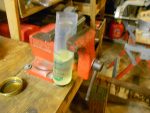 I decided to experiment with another solution. I had an old, refillable camping squeeze tube in a box in my barn. I bought a 13-ounce jar of petroleum jelly at a local big box store. I took the petroleum jelly to the barn, lit my Norwegian “Storm Kitchen” alcohol stove with the permanent metal match, and began melting a pot of snow on the stove.
I decided to experiment with another solution. I had an old, refillable camping squeeze tube in a box in my barn. I bought a 13-ounce jar of petroleum jelly at a local big box store. I took the petroleum jelly to the barn, lit my Norwegian “Storm Kitchen” alcohol stove with the permanent metal match, and began melting a pot of snow on the stove.
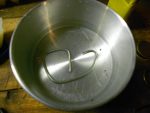 While the snow was melting, I made a coil from an old wire tent stake, and dropped it in the bottom of the pot. This was to prevent the bottom of the petroleum jelly jar from possibly overheating through direct contact with the bottom of the pot. I then put the jar of petroleum jelly on top of the coil of wire, and covered the pot with a larger pot to slow heat loss. I did this project in the barn so that I would not mess up my wife’s kitchen.
While the snow was melting, I made a coil from an old wire tent stake, and dropped it in the bottom of the pot. This was to prevent the bottom of the petroleum jelly jar from possibly overheating through direct contact with the bottom of the pot. I then put the jar of petroleum jelly on top of the coil of wire, and covered the pot with a larger pot to slow heat loss. I did this project in the barn so that I would not mess up my wife’s kitchen.
While the water was heating, I cleaned up the squeeze tube and set it with the refill opening up. I used the vise on my workbench to help hold the tube open and upright. I then made a funnel from an old milk jug that fit the opening in the squeeze tube.
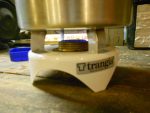 “Storm Kitchen” alcohol stoves usually take a long time to warm up, but once they warm they begin to burn much hotter. After about an hour, the little stove was really burning fiercely. The water boiled vigorously, and more than half of the petroleum jelly melted. At that point, I removed the petroleum jelly jar from the boiling water with a pair of pliers, and poured an appropriate amount into the open end of the squeeze tube with the help of the milk jug funnel. I then extinguished the stove, and went to take the dog for a walk while I let things cool down.
“Storm Kitchen” alcohol stoves usually take a long time to warm up, but once they warm they begin to burn much hotter. After about an hour, the little stove was really burning fiercely. The water boiled vigorously, and more than half of the petroleum jelly melted. At that point, I removed the petroleum jelly jar from the boiling water with a pair of pliers, and poured an appropriate amount into the open end of the squeeze tube with the help of the milk jug funnel. I then extinguished the stove, and went to take the dog for a walk while I let things cool down.
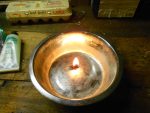 Twenty minutes later, the freezing temperatures in the barn had caused the petroleum jelly to re-congeal. I squeezed a small amount of jelly on to some dryer lint, and ignited the lint with the permanent metal match. When it was properly fluffed, the dryer lint/petroleum jelly combination worked almost as well with the metal match as a cotton ball/petroleum jelly combination. I still strongly prefer cotton balls for use with ferrocerium rods because they ignite more easily and consistently.
Twenty minutes later, the freezing temperatures in the barn had caused the petroleum jelly to re-congeal. I squeezed a small amount of jelly on to some dryer lint, and ignited the lint with the permanent metal match. When it was properly fluffed, the dryer lint/petroleum jelly combination worked almost as well with the metal match as a cotton ball/petroleum jelly combination. I still strongly prefer cotton balls for use with ferrocerium rods because they ignite more easily and consistently.
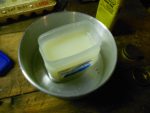 The 13-ounce jar of petroleum jelly cost me $3.49, giving me a cost per ounce of 27 cents. If you don’t happen to already own a camping squeeze tube, they were listed at the time of this writing on Amazon at two for $3.78 . So including the costs of the tubes, your first batch would come to $.56 per ounce, with subsequent batches costing less than half that.
The 13-ounce jar of petroleum jelly cost me $3.49, giving me a cost per ounce of 27 cents. If you don’t happen to already own a camping squeeze tube, they were listed at the time of this writing on Amazon at two for $3.78 . So including the costs of the tubes, your first batch would come to $.56 per ounce, with subsequent batches costing less than half that.
There is one other source of accelerant in tubes that you should be aware of. If you are inspecting your first aid kit or medicine cabinet, and you discover that your tube of triple antibiotic ointment is outdated, don’t throw it away. The ointment consists primarily of petroleum jelly. Instead, use the tube of ointment as a handy dispenser of fire starting accelerant.
Conclusion
I am very satisfied with the permanent metal match. It seemed to ignite reliably under a variety of temperature conditions, withstand immersion in water, and resist excess fuel evaporation. I plan to make it my primary method of starting fires unless I happen to find something better. As opportunity allows, I hope to purchase a couple more: one for our fireplace, and one for my mini survival kit.
Disclaimer
I did not receive any financial or other inducement to mention any vendor, product, or service in this article.

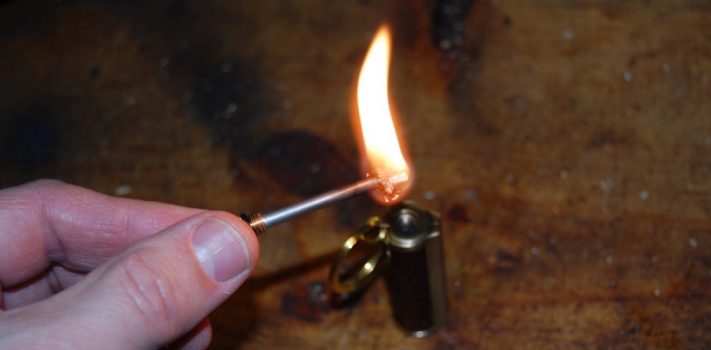









I recently came across some small travel size containers of petroleum jelly, 1.75oz & .25oz, which allows me to store the cotton balls dry, separate from the jelly. This seems to be less messy…
I have a really nice one that I got from countycomn.com. The only down side to most if not all of them is that they have zero wind blocking. A good old Zippo is much more wind resistant. Even better is to replace the Zippo insert with a Thunderbird butane “blue jet” insert. Almost completely wind proof.
Butane boils at around 32 degrees F. This means at colder temperatures, the liquid will not vaporize and the lighter will not work. While it is true that the lighter can be kept in your pocket, under very cold conditions you may still not be able to light it. The same holds true for butane stoves.
I had one of these years ago. It was a constant in my hiking kit. Unfortunately I lost if someplace over the years. I’d like to find another one, or even two, but haven’t been able to find a decent one for sale in Canada. Thanks for the article as it has reminded me that I need to renew the search.
Thank you for the article, much information and very thorough. For cotton balls, I use a spoon and smear the Vaseline all over the cotton ball, then put them in an Altoids tin. Six is best for me as eight mushes them together and it makes a bigger mess getting one out. I also agree with keeping the wife happy. Starting this experiment off I smeared the cotton balls in the Vaseline jar. Guess who was not happy with cotton ball threads stuck in the jar?
The Dollar Tree store usually has petroleum jelly in a plastic container and in tubes.
Hi Sis, Our Dollar Tree does not carry petroleum jelly in tubes. I wish they did.
Since probably all “metal matches” are not equal, it would be helpful if you posted the specific model and source of the one you tested.
Hi John, Sorry for the lack of detail. It was a gift, and the package did not contain the information you requested.
I melt petroleum jelly with wax in a double boiler setup, a 13oz pj as shown along with 4oz-8oz or more of wax. The wax makes the pj less messy and the pj makes the wax softer.
Melt the pj and wax and then pour into a gallon sized zip top bag with 125 large cotton balls. While the mixture is still liquid gently squeeze the air out and seal the bag. The cotton balls are absorbent and will be saturated with the mixture. Let cool, turning and manipulating the cotton balls so the mixture doesn’t settle and pool.
After the mixture firms up a little bit you can let in air and continue to work it to help keep the cotton balls from bunching up into mass. To use the PJCBs just pull off a piece and it will look like the muppet Beaker with the fine fibers of the cotton sticking up. Those fibers take a spark really well and one of the balls can burn for 10+ minutes. If you don’t need that kind of burn time then just pull off a smaller chunk and save the rest of the PJCB for another fire.
Hi ATS, Great tip. Look forward to trying that.
Crafty stores often have candle making supplies and you can get some tabs for coloring the PJCBs. I like orange and bright green. Lol
I buy my supplies at Walmart and depending on the cost of the store brand PJ my cost is four to five cents each. As a young man I strove for making one match fires. The large cotton balls, large not jumbo, can be used to start five to ten fires since you can pull them apart into pieces that will burn as long as a standard strike anywhere wooden match.
I make a poor man’s cosmoline by mixing ~10% petroleum jelly with ~90% wax melted in a tin sitting in boiling water. I mix it thoroughly and brush it on. It helps to warm the item with a hair dryer so that it cools a bit more slowly. Most solvents will remove it pretty well, but you can also rub it off with a rag and it leaves a light oily film. You can play with the ratio to get different characteristics.
I’ll have to try your mix ratio with cotton balls. I usually use straight PJ for that, but I’m always up for a new trick. Thanks.
Coughlan’s makes a unit that comes with half a dozen or so cotton/wax tinders. I’ve had success with it with or without adding Naptha. It is pretty inexpensive. Makes for a great cache item. Peanut lighters are similar. That o-ring is the key to keeping Naptha from evaporating. Good for long term storage, not so much for regular use, as those o-rings wear out.
Another great tinder idea, some of the softer lip balm sticks do a good job of embedding in cotton balls and will catch a spark pretty much like PJ does. Easier to carry.
I like to use empty zip fizz tubes to hold 3 or 4 PJ cotton balls. I tie some floss on them as I stuff them in the tube, making it easy to retrieve them later. Mess free and convenient. I suppose you could use small medicine bottles or some such. Whatever works.
Hi Benjamin, that Cooughlan’s unit sounds interesting. What is it called?
The lip balm sounds like a great tip as well.
“I have been searching for a durable and reliable tool/process to be my tertiary fire-starting method”
large magnifying glass.
Hi Howdy, I have a fresnel lens, but for my tertiary fire-starting method I would want something that works in the dark.
Interesting concept of the permanent metal match, but as with everything it’s not really permanent, requiring a refill of the energy source. IE: if you’re out in the hinterboonies for a couple weeks, you not only need the match but the fuel source.
Until of course, fraud in da house incorporates the greenie deal into everything, then it’ll all be powered by solar panels and windmills, requiring a 40 ft box van to haul all the crap around needed to start a fire, all lectric powered of course, cause we only got another 10 years left on the world expectancy ya know.
Pretty soon we’ll have progressed so far that we’ll be rubbing sticks together and trying to make sparks with a couple rocks…..Now that’s progress.. Bwwwaaaahhhhaaaaa
I really do like the concept though… Thanks for the info, I’m always interested in new things people come up with..
Metal match will still work as a firestarter even without liquid fuel. It is a sparker first and foremost. I’ve used mine without any liquid to start tinder just with the sparks.
I bought several of these from the BudK catalog years ago. They are rectangular vs. round as pictured, about an 1 1/2″ high, 1″ wide and 1/4″ thick. I tested one of my units and it would light for around a year (every couple of months tested, not every day). Not bad – a pair of those with lighter fluid can is well worth stashing.
Here’s the Coughlans website:
https://www.coghlans.com/fire-starter/flint-tinder-and-kindling/tinder-kit-8647?returnurl=%2ffire-starter%2fflint-tinder-and-kindling%2f
Hi Benjammin, Thanks for the link.
Good article. Of concern in today’s news: HR 127 Gun control….Firearm registration:
The bill states that the AG, by way of the ATF, will make a system for licensing the possession of guns and ammunition so that we can register each gun with the ATF.
They want each gun owner to give the ATF the following information:
Make
Model
Serial Number
Owner’s identity
Date acquired
Where it’s stored
Identity of anyone who it’s loaned to
They want this info three months after the effective date of the bill if you owned the gun before the bill went into effect. For each gun you buy after the bill goes into effect, the info will be needed the day of purchase.
Database:What good is a firearms registration without a database, which is also in the bill. The AG will establish and maintain a database of ALL registered firearms.
That database will be made accessible to all members of the public, all federal, state, and local law enforcement, all branches of the military, and all state and local governments.
Gun license:
The AG will issue a gun owner license to possess a gun and ammo. The licensee will be at least 21 years of age, and complete the following —
Criminal background check
Psychological eval
Complete a training course that is at least 24 hours long
Be insured
Your license will be denied or revoked if you are found to be psychologically unfit for any number of reasons.
License suspension: After granted, your gun license may be suspended if you don’t follow the rules. If you don’t have the firearm insurance the AG has the right to suspend your gun license. And if your license is suspended you have to return it and surrender all guns and ammo.
License renewal:
In order to renew your license you must continue to jump through hoops. The AG will renew a license if requested by a certain period of time and as long as you’ve gone through at lest eight hours of training.
Firearm insurance:
This part doesn’t make a lot of sense to me in that I’m not sure who is giving the insurance out, but it seems like it’s the Attorney General — who I wasn’t aware issued insurance policies. I could be wrong on this.
Also interesting is that the insurance costs $800. I’m unaware if it’s per gun or total. And to be honest, I wouldn’t put anything past them idiots at this point.
https://www.concealedcarry.com/law/whats-in-hr-127-nothing-good/
PrepHOU,
Thank you for the information. As predicted, there will be a bum’s rush of stuff flying at Americans.
Usually they ask for the moon and “compromise”, taking just a little each time. This time it will be more than a little. Next time even more until there is nothing left to give.
We’ll see.
If it becomes law, ignore it.
i doubt it will become law.
The Novice:
Great article, I have matches in our BOB but this looks like something I need also.
Thanks for the article,
Regards and God Bless you and your family,
Hi Francis,
Thanks for the encouraging word.
the metal match vary widely in quality, like everything made in China, if they are told firmly to make something to a Western ISO standard, they do ! otherwise cheap, cheap, cheap.
I had one of these 50 years ago. Probably in a box somewhere. Over the years of moves I lost track of it. One thing I remember, It never leaked or dried out, unlike my Zippos.
Tons of articles on starting/building fires.I’d love to see one on different ways of “carrying” fire..I.E. a smoldering coal/ember…twisted up grasses…hemp rope…etc…
I used to use the petroleum jelly and cotton balls method, but it’s so darn messy, and also the PJ is very sooty and smoky when it burns. I’ve recently changed to a different method that I like better. I was able to purchase 3 boxes of large candles at a yard sale for $20. The candles had been used for table decoration at a wedding reception and were nearly new. They have a light fragrance, but it’s quite pleasant. I have an old enamelware pot, and I can melt one of the candles in it (they’re 5-6 inches tall & 3 inches in diameter) on our wood stove in a few minutes. I dip cotton balls in the melted wax and place them on a cookie sheet lined with parchment paper. One candle will make nearly 50 fire starters. For ease of lighting, I pull and twist up a “wick” on the cotton ball before dipping. I use a tweezers to dip them. If one were really thrifty, one could separate each cotton ball into several pieces before dipping. These fire starters become solid once cooled (I just stick the tray in the freezer for a couple minutes) and aren’t messy at all. When using a ferro rod to light one of these, you just have to pull up a few fibers away from the cotton ball to catch the spark.
I like make up pad removers better than cotton balls. Make a Al foil boat and smear PJ over the top and melt in the oven. 1/2 pad will be more than enough for a fire. They fit real nicely into a can of Skoal.
Fire straws are easy to make and carry. Just make your cotton and petroleum jelly balls and take a plastic straw cut to what ever length you want and stuff the cotton mix into the straw and seal by heating the open ends of the straw and crimping the melted straw. Makes a waterproof starter that can be carried anywhere. Just clip an end open and pull out the amount needed or use the whole straw ,once started even the plastic burns .
Let me start by saying I am a pack a day smoker and a lover of the zippo line of lighters and matches.
Zippo is an American/Canadian company.
I have used a ZIPPO metal match for years and carry them in all my BOB , vehicles and hunting bags.
They are durable and I have never had an issue with any of them. I use zippo lighter fluid and with normal use the mat h usually last about three days of use.